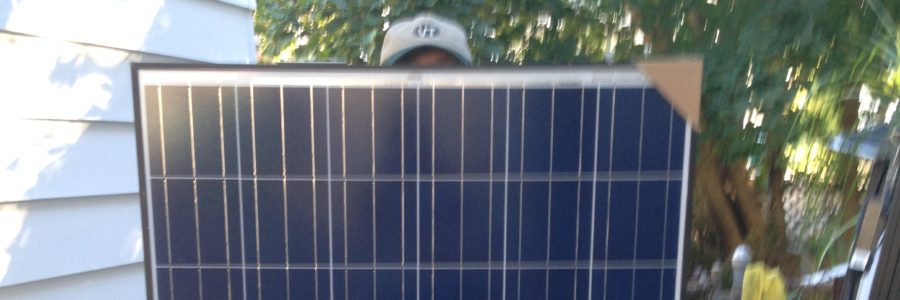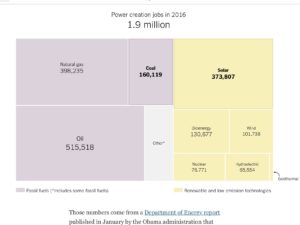
We Need More Daylight on the Solar Panel Tariff
 The solar industry is the fastest growing occupational sector, per the US Department of Labor. It is a $28 billion dollar a year industry and is expected to grow more that 105% in the next ten years, far greater growth than any other sector. However, this status and growth projection will be adversely affected by the tariff the White House recently placed on imported solar panels.
The solar industry is the fastest growing occupational sector, per the US Department of Labor. It is a $28 billion dollar a year industry and is expected to grow more that 105% in the next ten years, far greater growth than any other sector. However, this status and growth projection will be adversely affected by the tariff the White House recently placed on imported solar panels.
“Why?” you may ask. “Aren’t tariffs on foreign goods intended to encourage purchase of local goods? Isn’t that a good thing?”
Yes, when there is an existing domestic production, this works rather well. If we put a significant tariff on apple juice from China to counteract the cheaper prices due to their fewer regulations on processing and packaging, we have ample cider production in New York and NE to pick up the slack and benefit from the opening up of the market. In the solar industry, however, production of photo-voltaic (PV) panels is currently over 80% foreign, and even the two domestic producers are not owned by USA companies. We don’t have the capacity in place in the USA, or even planned, to meet demands.
And many say the tariff makes it harder to start a PV manufacturing business in the USA. If the goal of the tariff is to increase domestic manufacture of panels, it is not well structured to do so. It is one year 30% hit, with planned decreases over a four-year period, making it a 15% tariff in year four. Anyone now contemplating starting a manufacturing business will have a scant four years at best to build a company, begin work, refine the manufacturing, and gain a solid market share before the tariff dissipates and all financial advantages to domestic production disappear.
 If the intent were to create local production, why not directly affect local production with worker training, tax waivers for start-ups or continued or increased government support of installations? And why announce this tariff in nearly the same breath as “saving coal workers’ jobs”. In reality the tariff is weak enough that imported panels will often still be cheaper than domestically manufactured panels, further damaging increase in local production, all while making all PV solar projects across the board more expensive.
If the intent were to create local production, why not directly affect local production with worker training, tax waivers for start-ups or continued or increased government support of installations? And why announce this tariff in nearly the same breath as “saving coal workers’ jobs”. In reality the tariff is weak enough that imported panels will often still be cheaper than domestically manufactured panels, further damaging increase in local production, all while making all PV solar projects across the board more expensive.
A typical homeowner will experience an additional $500-$1,000 burden (per EnergySage.com), which is not a lot, but certainly dampens the return on investment (ROI) calculations and does nothing to encourage homeowners to move to renewable energy. When you understand the order of magnitude when discussing commercial and district energy installations you can see how this tariff will cost everyone too much.
The biggest issue is the undermining (pun gleefully accepted) of the market growth in solar installations. And we need every mega-watt we can get in the face of rising CO2 emissions and climate change data. Imagine if 20% of the homeowners looking at solar decided to turn away from the installation, based on this up-tick in cost? And what if 10% of the commercial projects could not make the cost-case? The demand overall goes down and the spiral begins, further dis-incentivizing any local production of PV. This tariff is cutting the legs off an industry that is ready to fly, but needs to still run to get airborne. The tariff begins to look more like an attempt to kill off the solar industry.
There is already a large US company, Sun Power, that is demanding an exception from the tariff so they can continue planned US expansion while they maintain levels of current PV production in Mexico and the Philippines. They have put a hold on their $20 million expansion, and stopped interviews for the jobs.
We have to do something to increase local production of PV panels. The installation jobs will always be local and we can do more to insist on local designers and to support increase in local manufacturing. I do not see a tariff on foreign panels as an intelligent way to get us there, and from my readings I am not the only one. There is not enough occurring locally to fill the created gaps, and in that moment of not filling the gaps, the momentum will fall off, leaving us with not only fewer jobs in the USA, but much less to help us in weaning off of fossil fuel.
 But then again, I think that was the point.
But then again, I think that was the point.
Hug your solar installer,
Jodi
Be the first to like this post (no login required)
